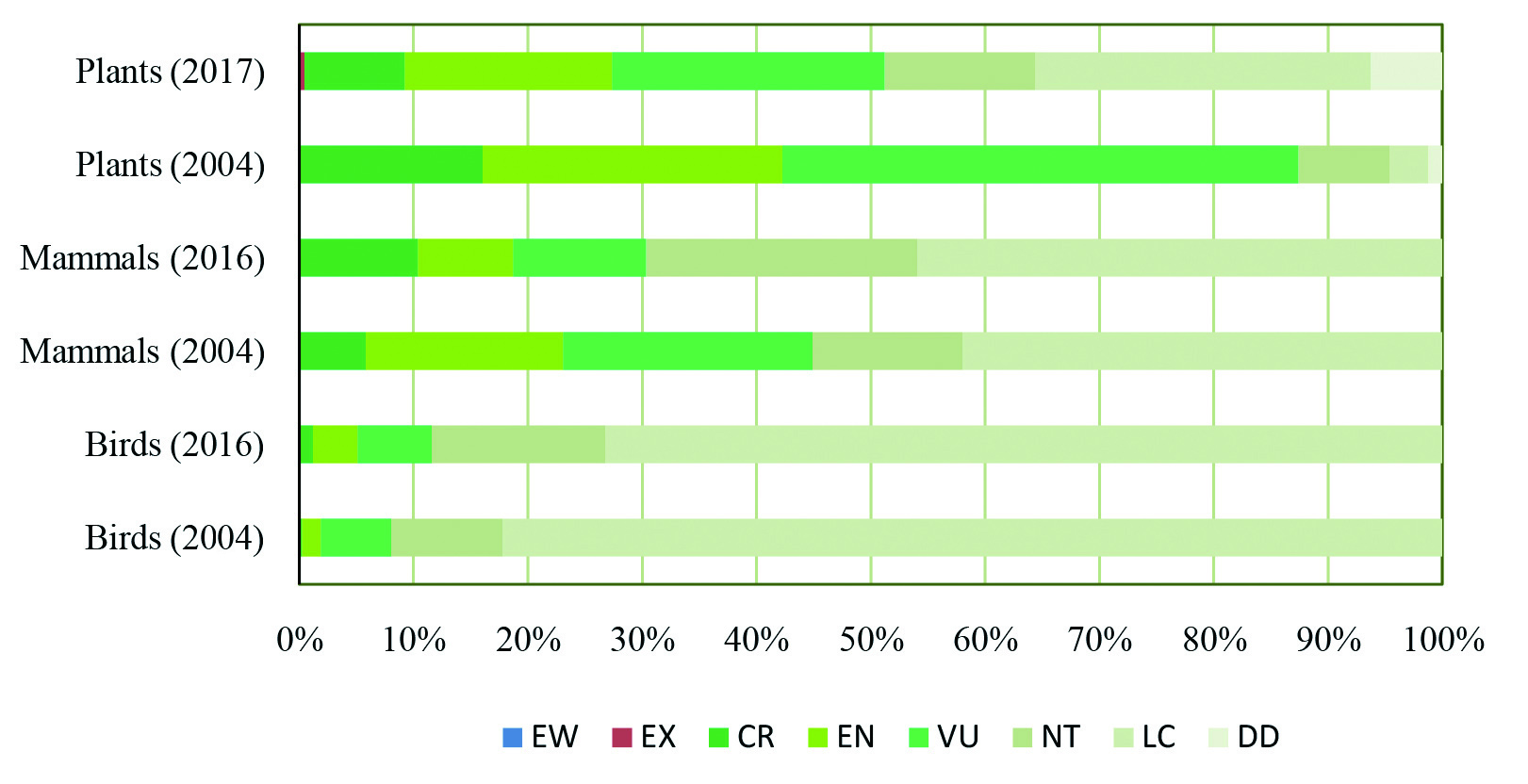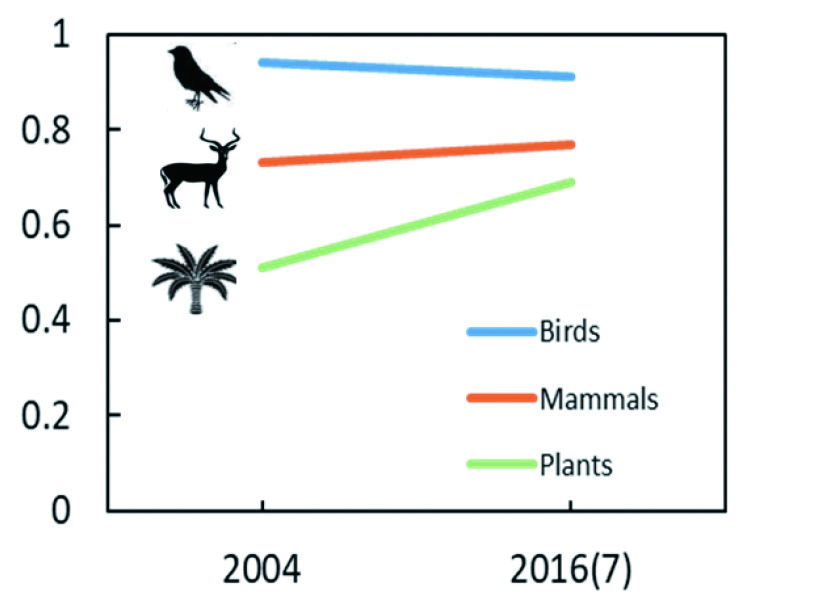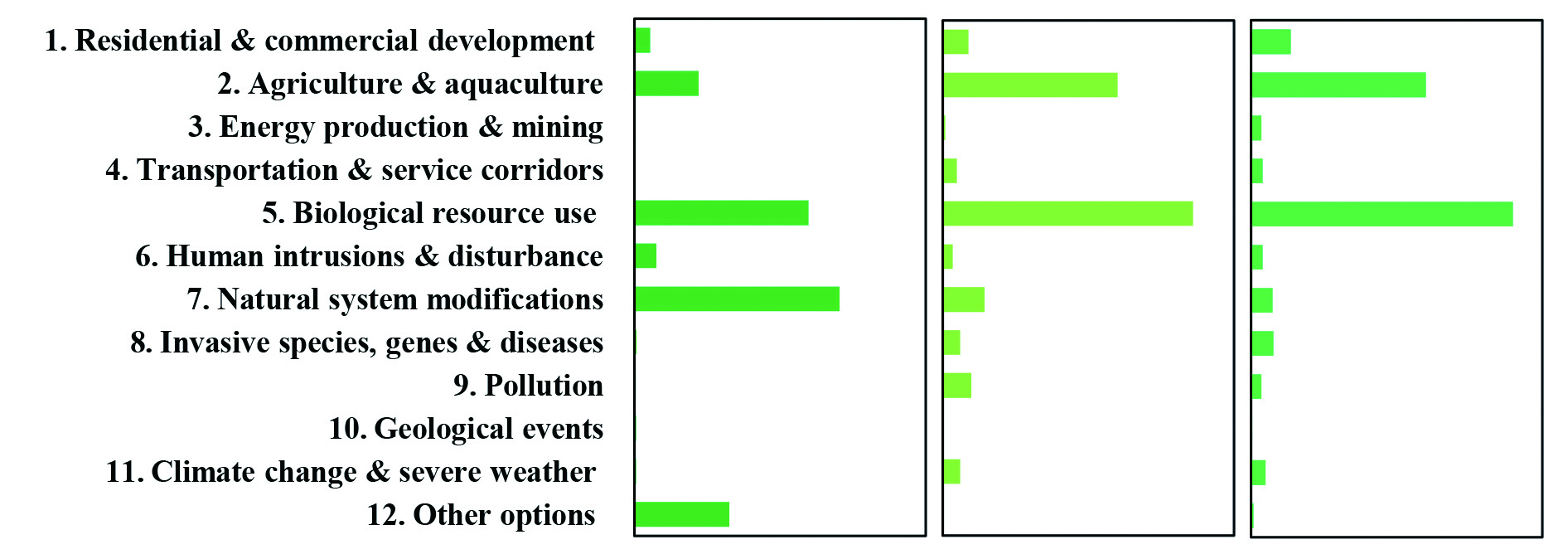SDG15: Life on Land
Evaluation of the Red List Index of threatened species in China(2019)
Scale: National
Study area: China
Climate change and human activities are currently threatening global biodiversity. Researchers have proposed a Red List Index based on the red list of species of the International Union for Conservation of Nature (IUCN) to assess changes in biodiversity and the effectiveness of conservation measures. This indicator is one of the most effective means for assessing endangered species and has been listed as one of the evaluation indicators in the UN MDGs. Moreover, the indicator has been widely used in the assessment of conservation progress at global scales. Many countries have conducted a national-scale assessment using the Red List of Species due to availability of detailed and accurate species information. The Red List of Chinese Species was first released by China in 2004 and was updated in 2016-2017. The Red List Index is calculated based on the National Red List of Species and accurately reflects the changing biodiversity trends in the country and guides conservation work at the national level. In this study, the Red List Index in the National Red List of Species was used to assess the threat levels to higher plants, terrestrial mammals, and birds in China from 2004 to 2017. The goal was to provide a basis for the study of biodiversity and the formulation of conservation strategies in China.
Target 15.5: By 2020, take urgent and significant action to reduce the degradation of natural habitats, halt the loss of biodiversity, and protect and prevent the extinction of threatened species.
Indicator 15.5.1: Red List Index.
Method
The first assessment of the red lists for higher plants was gathered from China Species Red List, Vol. 1: Red List. The second assessment was obtained from the China Biodiversity Red List—Higher Plants with some minor revisions from the special issue of Higher Plants of China published in Biodiversity Science. The two assessments of terrestrial mammals and birds were obtained from China Species Red List, Vol. 2: Vertebrates and the Chinese Red List of Vertebrates.
Species that have been evaluated at least twice can participate in Red List Index calculation. Moreover, species that were first assessed as extinct (EX/EW/RE), and any species that were once assessed as data deficient DD were not used in the calculations. A total of 3,948 higher plants, 568 terrestrial mammals, and 1,213 birds were used in the calculation of the Red List Index.
Data used in this case
The data were derived according to the IUCN classification criteria for threatened factors. These factors referred to the spatial data of human activities, including the population density, the number of highways and waterway entrances, power infrastructure, urban areas, and farmland.
Results and Analysis
(1)Changes in the threatened status for species.
From 2004 to 2017, the proportions of higher plants that have declined, remained stable, and improved in status were 7.9%, 37.4%, and 47.8%, respectively, with a few species going extinct. The numbers of mammal species that are critically endangered (CR) have increased, while the number of species that are endangered (EN) and vulnerable (VU) have declined. The number of threatened bird species (including CR, EN, VU) has also increased.

Figure 1. Changes in the threatened levels of higher plants, terrestrial mammals, and birds in China.

Figure 2. Red List Index for higher plants,terrestrial mammals, and birds in China.
(2)Red List Index
The results of the Red List Index evaluation show that (Figure 2), Red List Index of birds declined slightly, while mammal index was on the rise. For higher plants, the Red List Index was 0.51 in 2004 and increased to 0.69 in 2017. This suggested that their overall endangered status of higher plants and terrestrial mammals in China has been improved. After the first assessment of threatened species in 2004, many conservation measures have been taken by national and local biodiversity conservation organizations and units, and even many protected areas have been established and conserved for some species. Therefore, many endangered species have been effectively protected since 2004, alleviating their endangered status to a certain extent, and making their Red List Index show an upward trend.
(3)Threats to biodiversity loss
Among the 12 categories of threats leading to biodiversity loss, the use of biological resources and agriculture/aquaculture development are the main threats to China's terrestrial mammals and birds. Higher plants are mostly threatened by natural system modifications and the use of biological resources. Controlling these threats is an effective means for stopping the decline of threatened species and curbing biodiversity loss.
These findings reveal that several changes in the threatened status of higher plants, terrestrial mammals, and birds have occurred in China over the past decade. Results suggest that conservation actions have mostly improved the threatened status of higher plants and terrestrial mammals. However, some groups such as bird species have been declining in threatened status, suggesting that urgent action is needed to reverse their decline. This study provides scientific information to guide species conservation in China and demonstrates the potential of using a national species red list for biodiversity conservation.

Figure 3. Composition and proportion of threatening factors faced by higher plants, terrestrial mammals, and birds in China.
| Highlights |
Results reveal that the Red List Index for higher plants and land mammals in China was on the rise from 2004 to 2017, and their endangered status has been improved. Bioresource use and agriculture/fishery development are the main threats faced by terrestrial mammals and birds in China. Higher plants are more exposed to direct threats from ecosystem changes and over-exploitation. These threats can be controlled to reverse population decline and curb biodiversity loss. |
Outlook
The Chinese red list includes more species than the IUCN red list. For example, in the red list of higher plants, only 600 species of higher plants distributed in China were ranked as threatened categories on the global level assessment. However, more than 3,800 species were classified as threatened according to the national red list. Therefore, the national red list can more accurately reflect the threatened status of global species within China. The national red list and the Red List Index calculated at the national scale serves as a better guide for national conservation management and should be promoted in the future.
Some species are significantly more threatened than others because of their intrinsic biological traits, or because of differences in anthropogenic threats. Therefore, specific groups should be analyzed separately when using the Red List Index to evaluate the threatened status for species. This can aid in identifying both the true status and driving factors, and enabling timely actions to ensure their protection.
The next step is to strengthen the analysis of threats to species and their spatial patterns to provide targeted support for protection and management. This will assist in slowing the rate of biodiversity decline and reversing biodiversity loss.

